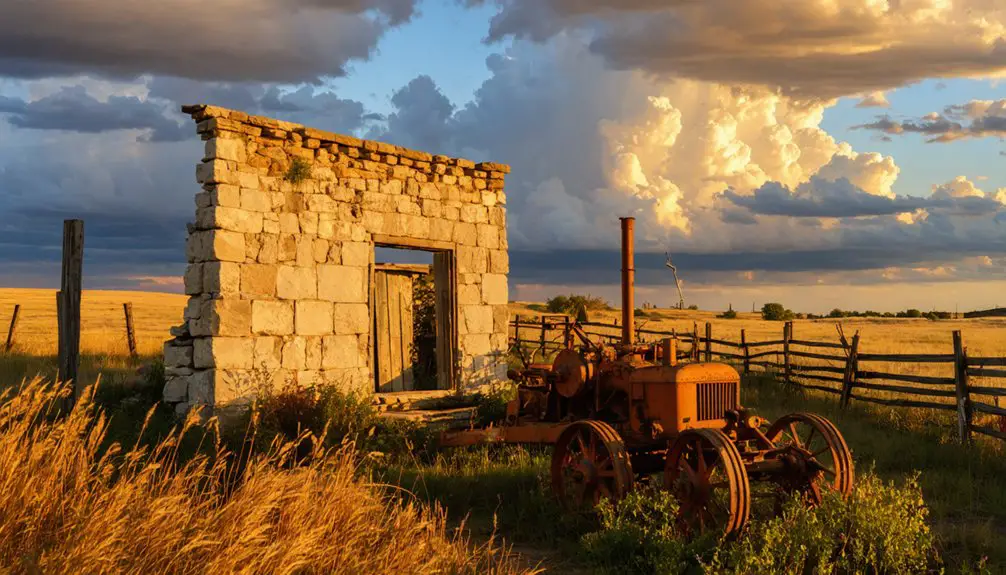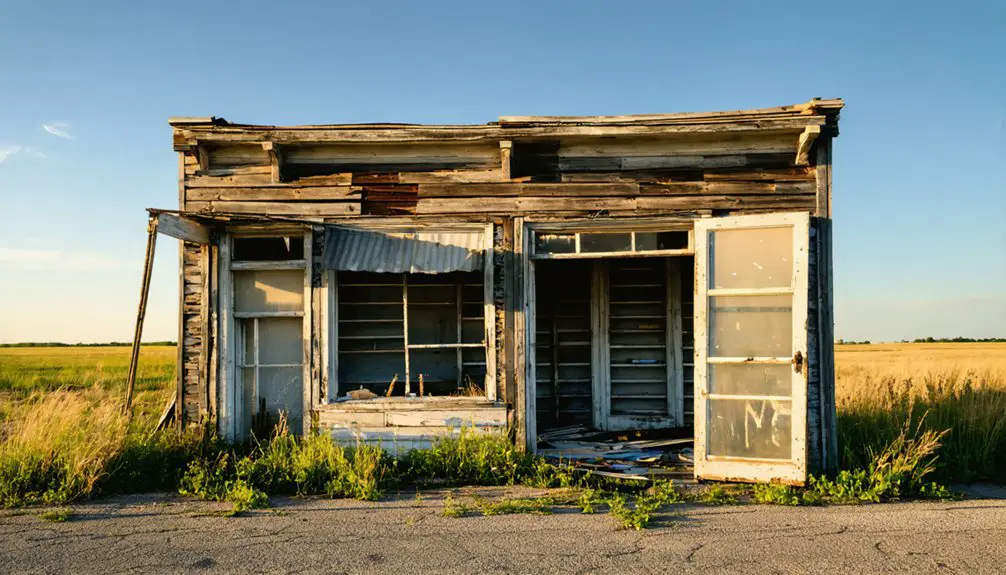You’ll find Uniontown’s haunting remains along the south bank of the Kansas River, where it once served as an essential trading post for Oregon-California Trail pioneers. Established in 1848 on Potawatomi land, this bustling frontier town boasted 60 buildings, including 14 stores and 19 saloons. Devastating cholera epidemics in 1849 and 1850 led settlers to burn the town, ultimately causing its abandonment by 1859. Today, a historic cemetery and scattered stones reveal a complex tale of frontier dreams and tragedy.
Key Takeaways
- Established in 1848 as a Potawatomi trading post, Uniontown grew into a bustling frontier settlement with 60 buildings along the Kansas River.
- Served as a crucial stopover for thousands of Oregon Trail and California Gold Rush travelers, featuring 14 stores and 19 saloons.
- Devastating cholera epidemics in 1849 and 1850 led residents to burn the town, with victims buried in a mass grave.
- The town was completely abandoned by 1859 due to disease, competition from nearby settlements, and changing transportation routes.
- Today, only the historic cemetery and a dated stone in the Green Wildlife Area remain as physical evidence of Uniontown’s existence.
The Birth of a Trading Post on Native Land
When the U.S. government sought to establish a trading hub for the Potawatomi tribe in 1848, they chose a strategic location on the south bank of the Kansas River, creating what would become Uniontown.
Indian agents R.W. Cummins and A.J. Vaughan initiated this outpost in Dover Township, opposite present-day Rossville, to serve as a crucial pay station and trading center.
The trading dynamics quickly evolved as Thomas N. Stinson, a former Potawatomi Agency blacksmith, built the first house and managed the post.
Under Stinson’s leadership, the trading post evolved from a simple outpost into a bustling hub of frontier commerce.
You’ll find that cultural exchange flourished here, with the settlement attracting both Native Americans and traders of French-Indian descent. The post handled massive transactions, including one notable payment of $130,000 to the tribe.
The settlement grew to include approximately sixty buildings at its peak, making it a bustling frontier town.
The government’s establishment of shops and a mill on Mill Creek transformed this frontier outpost into an indispensable commercial center, where the Potawatomi could access supplies and services within their designated territory.
Life Along the Oregon-California Trail
As you stood at Uniontown’s bustling trading post in the 1840s, you’d have witnessed a constant stream of Oregon and California-bound emigrants stopping to resupply and repair their wagons.
You’d have found yourself among the 500,000 pioneers who traversed the overland trails between the 1830s and 1860s, with many facing the harsh realities of cholera outbreaks, resource scarcity, and extreme weather conditions. The Barlow’s Toll Road provided a crucial new route for pioneers in 1846, extending the Oregon Trail’s reach.
While stationed at this essential rest stop along the trail, you’d have encountered wagon trains of families and prospectors alike, all seeking the promise of new opportunities in the American West. The discovery of gold in January 1848 led to an unprecedented surge of travelers rushing westward to seek their fortunes in California.
Pioneer Trading Hub
During the peak of westward expansion, Uniontown emerged as a vital trading hub along the Oregon-California Trail, strategically positioned near the Kansas River crossing in Shawnee County.
You’d find about 60 buildings at its height, including 14 stores and 19 saloons that doubled as hotels, addressing pioneer challenges with innovative trading solutions. The ferry service at the crossing could transport up to 70 wagons daily.
As one of the last major supply points west of the Mississippi, you could stock up on essential provisions like foodstuffs, firearms, and tools.
The trading post’s services went beyond basic commerce – you’d find blacksmiths, medical care, and facilities for horse and oxen resupply.
Whether you were a Potawatomi tribal member, gold seeker, or emigrant, Uniontown’s vibrant marketplace served as your lifeline before starting on the challenging westward journey. The town’s significance grew when Captain John C. Fremont crossed the nearby Kansas River ford in 1848.
Daily Life Realities
Life along the Oregon-California Trail demanded a strict daily routine that began well before sunrise, typically around 4 a.m., with bugle calls or rifle shots rousing travelers from their sleep.
You’d quickly pack up camp, tend to animals, and hit the trail by 7 a.m., facing pioneer challenges like dust, disease, and dangerous river crossings.
Walking beside wagons for 15-20 miles daily, you’d witness remarkable community resilience as families worked together to overcome obstacles. The caravan would stop for a midday nooning break to rest and feed the animals.
Women managed cooking and childcare while men scouted ahead and handled camp security. Travelers often used compact prairie schooners rather than large Conestoga wagons for the journey.
At night, you’d join others around campfires for singing and storytelling, finding comfort in shared experiences.
Sunday brought welcome rest, allowing time for religious services, laundry, and equipment repairs.
Despite harsh conditions, these structured routines and social bonds helped pioneers endure the journey’s hardships.
Commerce and Social Development
When Uniontown emerged in 1848, it quickly established itself as an essential commercial hub serving both the Potawatomi tribe and westward travelers. You’d find Thomas N. Stinson’s trading post at the heart of commerce, where substantial government payments to the Potawatomi – sometimes exceeding $130,000 in gold and silver – fueled the local economy.
At its peak, the town’s social infrastructure included 60 buildings housing nearly 300 residents. You could visit any of the 19 saloons doubling as hotels, trade at various merchants, or seek services from physicians, blacksmiths, and gunsmiths. The Uniontown Mill built in 1871 processed up to 125 bushels of wheat daily.
The 1878 Methodist Church and 1871 two-story school reflected the town’s commitment to community life. The 1880 arrival of the St. Louis, Fort Scott & Wichita Railroad further expanded economic activities, connecting you to broader markets.
The Devastating Impact of Cholera
As devastating cholera epidemics swept through Uniontown in 1849 and 1850, you’d witness the tragic deaths of hundreds of Potawatomi and non-native settlers alike.
Cholera ravaged Uniontown mercilessly, claiming hundreds of lives among both Potawatomi natives and settler families in 1849-1850.
At its peak before the epidemics, sixty structures stood in the bustling settlement.
The community’s desperate attempt to contain the disease led them to burn the entire town in 1849, though this drastic measure couldn’t prevent a second outbreak in 1850.
You’ll find evidence of the community trauma in Uniontown Cemetery, where a mass grave holds up to 35 cholera victims.
Local oral traditions suggest hundreds more victims lie buried in surrounding fields. A prominent cottonwood tree serves as a sacred marker for these burial grounds.
Despite rebuilding efforts and establishing a ferry service in 1850, the recurring outbreaks proved too devastating.
The town never recovered, leading to its complete abandonment by 1859.
The Failed Experiment in Native American Policy

You’ll find that Uniontown’s failure as a government trading post reflects the broader flaws in federal Native American policy during the mid-1800s.
The settlement’s design as both a controlled trading hub and payment station undermined Potawatomi self-sufficiency while exposing them to disease and disrupting their traditional ways of life.
What began as a supposed experiment in Native American “management” through concentrated settlements ultimately contributed to the displacement and suffering of the Potawatomi people, leading to Uniontown’s complete abandonment by 1859.
Federal Policy’s Fatal Flaws
The federal government’s mismanaged Indian policy framework of the mid-1800s created devastating ripple effects throughout Native American communities like Uniontown, Kansas.
The repeated treaty violations and economic dependency forced upon Native Americans revealed fatal flaws in federal oversight. You’ll find that corrupt Indian agents, under-resourced programs, and paternalistic policies crippled tribal sovereignty while enriching non-Native interests.
The system’s failures manifested in four critical ways:
- Trading posts created unsustainable dependency on government-controlled commerce
- Inadequate medical infrastructure left tribes defenseless against deadly epidemics
- Weak land protections enabled systematic territorial dispossession
- Limited tribal self-determination undermined traditional economic practices
The results proved catastrophic as Uniontown’s Potawatomi community faced disease, displacement, and the eventual loss of their commercial center.
Unification Strategy Unravels
Despite ambitious federal plans to centralize and modernize Native American communities, Uniontown’s unification strategy crumbled under the weight of devastating health crises and unstable demographics between 1848-1850.
You’ll find that the government’s attempt to unite the Potawatomi faced immediate unification challenges. Cholera epidemics in 1849 and 1850 forced residents to burn their own settlement, revealing how quickly imposed communities could collapse.
The constant flow of travelers, settlers, and temporary residents along the Oregon-California Trail prevented any stable social foundation from forming. Meanwhile, tribal fragmentation continued as splinter groups remained scattered across Iowa and Kansas.
While federal agents like Cummins and Vaughan tried establishing economic control through trading posts and annuity payments, emerging towns like Topeka and Manhattan drew away crucial commerce, further undermining the experiment’s viability.
Decline and Abandonment
Once a thriving commercial hub along the Oregon-California Trail, Uniontown’s decline began dramatically with devastating cholera outbreaks in 1849 and 1850 that claimed hundreds of lives among both settlers and Potawatomi natives.
The epidemics triggered a severe economic decline and population loss that the town couldn’t recover from.
- Officials burned the town deliberately to contain the disease spread, leaving many buildings destroyed.
- Competition from rising towns like Topeka and Manhattan drew traders and settlers away.
- The town’s river crossing advantage diminished as new transportation routes emerged.
- A final fire in 1859 destroyed what remained of Uniontown, and by the 1870s, the area had transformed into farmland.
Today, only the historic cemetery remains, preserving the memory of those lost to cholera and marking where this once-promising settlement stood.
Historical Legacy and Modern Remnants

While Uniontown’s physical structures vanished long ago, its historical footprint endures through several significant remnants and cultural legacies.
You’ll find evidence of its historical significance at the Green Wildlife Area, where a dated stone from the original town still rests near the parking lot. The privately owned cemetery, now listed on the National Register of Historic Places, preserves the graves of 33 cholera victims and stands as a solemn reminder of the town’s tragic past.
The Green family’s stone house, built in the 1870s using materials from the abandoned town, represents one of the few tangible connections to Uniontown’s past.
The Green house stands as a lasting testament to Uniontown, its recycled stones echoing memories of the vanished settlement.
Archaeological findings continue to reveal insights into this once-thriving Potawatomi tribal center and crucial commercial hub along the Oregon-California Trail.
Frequently Asked Questions
What Was the Average Cost of Goods and Services in Uniontown?
You’ll find average prices weren’t documented precisely, but historical currency shows frontier trading posts charged premium rates, with essential supplies costing more due to transportation costs and remote location challenges.
How Many Native American Tribes Regularly Traded at Uniontown Besides Potawatomi?
You’ll find at least 4 major Native cultures regularly traded at Uniontown: the Kansa (Kaw), Shawnee, Delaware, and mixed French-Indian descendants, all using established trade routes through the region.
What Was the Exact Population Ratio Between Settlers and Native Americans?
You can’t know the exact settler demographics versus native relations ratio since no precise census records exist from 1848 Uniontown, though evidence suggests Native Americans initially outnumbered or matched settler populations.
Were There Any Notable Conflicts Between Uniontown Residents and Passing Emigrants?
You’ll find that direct emigrant tensions weren’t well documented, but criminals preyed on both residents and travelers, creating nighttime violence despite military efforts at conflict resolution during daylight hours.
What Specific Items Were Most Commonly Traded at Uniontown’s Marketplace?
Sharp as a hawk’s eye, you’d find staple grains, preserved meats, hunting supplies, and farming tools dominating trading practices. The marketplace dynamics centered around ammunition, firearms, and essential household goods.
References
- https://octa-trails.org/wp-content/uploads/2023/05/Ellis-Uniontown-and-Plowboy–-Potawatomi-Ghost-Towns.pdf
- https://www.potawatomi.org/blog/2024/10/31/researchers-search-for-uniontown/
- https://legendsofkansas.com/uniontown-shawnee-county-kansas/
- https://ksoutdoors.com/KDWP-Info/Locations/Wildlife-Areas/Public-Wildlife-Areas-in-Northeast-Kansas/Green/History
- https://octa-trails.org/archaeology/uniontown-and-plowboy-potawatomi-ghost-towns-enigmas-of-the-oregon-california-trail/
- https://www.potawatomi.org/blog/2018/10/03/remembering-uniontown/
- https://en.wikipedia.org/wiki/California_Trail
- https://www.legendsofamerica.com/oregon-california-trail-timeline/
- https://historicoregoncity.org/2019/04/03/oregon-trail-chronology/
- https://www.nps.gov/cali/learn/historyculture/index.htm



